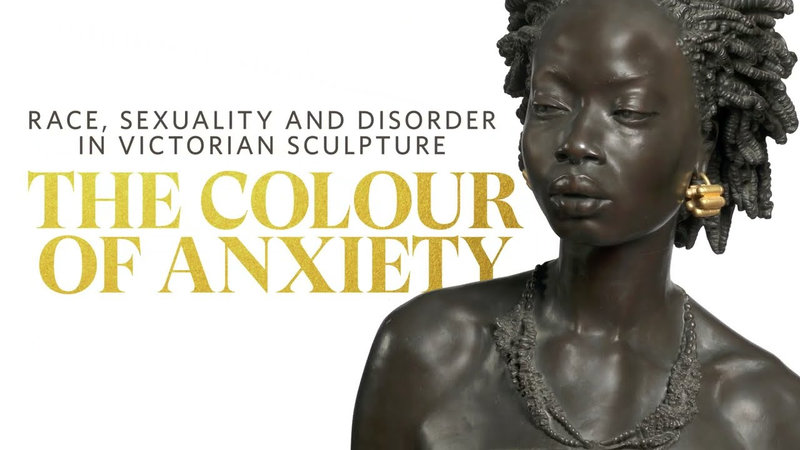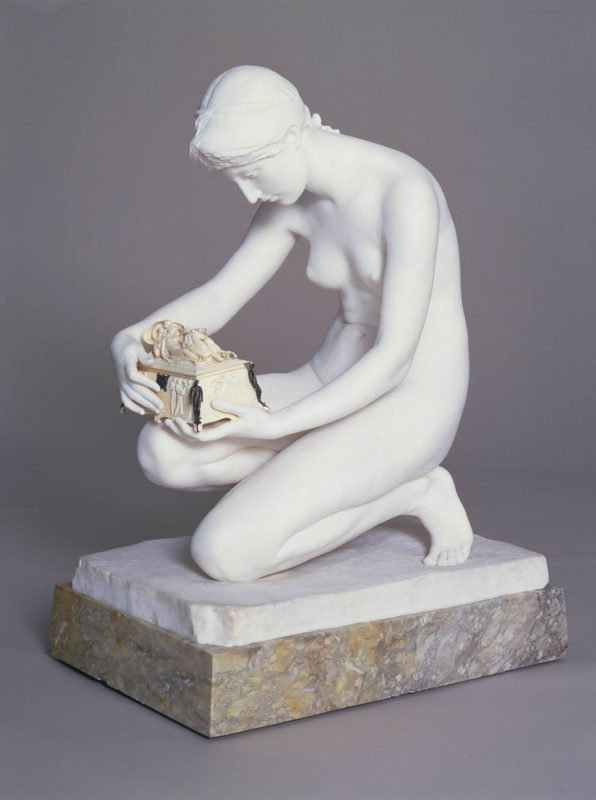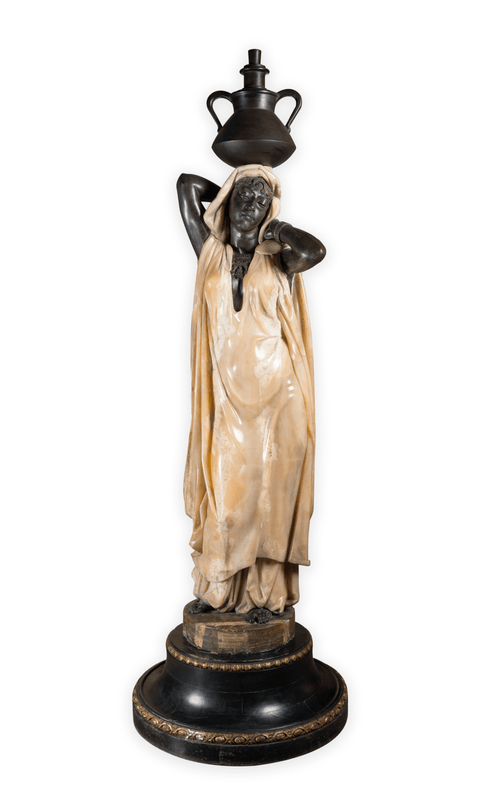'The Colour of Anxiety: Race, Sexuality, and Disorder in Victorian Sculpture' at Henry Moore Institute, Leeds
This winter the Henry Moore Institute in Leeds will present The Colour of Anxiety: Race, Sexuality and Disorder in Victorian Sculpture, bringing into focus sculpture exhibited and collected in Britain between 1850 and 1900, a rich yet largely overlooked body of work. The exhibition examines objects that introduced colour and new materials into the sculptural process, situating them within the context of the anxiety which often weighed upon Victorian society in the face of social change and scientific advances.
In the second half of the nineteenth century, British sculptors began to move away from the whiteness of Neoclassical marble and started to incorporate colour into their work, using bronze, silver, gold, ivory and porcelain as well as semi-precious stones, tinted waxes, enamels and paint. The adoption of these materials has typically been attributed to the renewed interest in medieval history and craftsmanship, discoveries about the polychromy of ancient sculpture, the allure of exoticism in the visual arts and the introduction of new industrial processes. Anxieties about rapid social change, developments in science, threats to the established patriarchal order and imperial rule have been highlighted by many literary and social historians but have received less attention from art historians.
The Colour of Anxiety examines the rise of colour in nineteenth-century sculpture by focusing on how male artists responded to, and reinforced, a concept of the cis female body influenced by anxieties of the time. Despite Victorian ideals of virginity and chastity, the representation of women in sculpture was increasingly sexualised, reflecting fears regarding the changing role of women, Black female sexuality and racial intermingling. Bringing together sculptures that either incorporate colour directly or imply it by means of subject matter and titles, the exhibition considers the fascination with colouring people and people of colour as a response to the perceived anxieties of the Victorian age.
The exhibition opens with works in white marble including Antonio Canova’s Venus (The Hope Venus) 1817–20 which symbolise Neoclassical ideals of femininity, purity and motherhood. These works refer both to the eighteenth-century historian Johan Joachim Winkelmann’s (1717–78) glorification of the sculpture of the ancient Greeks and to the underlying conviction that absence of colour was the sign of a civilisation capable of abstract thought and moral rectitude, in contrast to the painted figures of animist and pagan societies.
John Bell, 'The Manacled Slave / On the Sea Shore', 1877, bronze statuette. © Aberystwyth University School of Art Museum and Galleries.
Depictions of women of colour also drove the use of new materials, with leading sculptors actively choosing to represent women of African descent and mixed race, particularly enslaved women who embodied the complex and sexualised trope of the African or Black Venus. Fascination with the Middle East, the Holy Land and North Africa – known now as Orientalism – was another driver, with Black figures functioning as indexes of the exotic and racialised nature of the Orient, counterpoints to British whiteness and imperial power. Colourful and dark, Charles Cordier’s Femme Africaine 1857 was the ultimate ‘other’ in this complex topography at the time, signifying sexuality, servitude, barbarism and ethnographic degeneration, embodied in a luxurious decorative figure.
Racial mixing embedded in the image of the sexualised Black female slave was a further source of considerable anxiety during the nineteenth century. Sexual relations (mostly forced) between white men and Black enslaved women were a common but controversial practice that led to generations of slaves and former slaves who existed at an impossible crossroads.
Stories of these tragic figures, who were doomed to destruction due to the stigma of being of mixed race, abounded in Victorian literature and theatre. John Bell’s Octoroon 1868 immortalised this character in white marble. Sculptors including Cordier, John Bell and Jean-Baptiste Carpeaux also used the image of the Black female body to commemorate the abolition of slavery.
On display in the exhibition are Bell and Elkington & Co. The Manacled Slave / On the Sea Shore 1877 (a bronze statuette of Bell’s earlier full-size American Slave 1853) and a gilt-bronzed plaster version of Carpeaux’s Why Born Enslaved! (modelled 1868, carved 1873) which, while ostensibly abolitionist, nonetheless both sentimentalise and sexualise the captive slave body through depicting nude women in chains.
Sir George Frampton RA, 'Lamia' 1899-1900. Ivory, bronze, opals, glass. © Royal Academy of Arts, London. Photo: Paul Highnam.
Equally threatening to many men was the education of women and prospect of female emancipation. Education was seen as damaging to the female reproductive organs, threatening the survival of the human race. These fears manifested themselves through popular stories about female and lesbian vampires and in the image of the femme fatale, as in George Frampton’s Lamia 1899–1900, half-woman, half-snake and Harry Bates’ Pandora 1890. Artists such as Alfred Gilbert also produced serial images of sleeping or dead women, a theme which recurred in popular fairy tales such as Sleeping Beauty and was reflected in the taste for pale, consumptive women.
This historical exhibition will see significant works reinterpreted for the contemporary world. The Colour of Anxiety features largely white male artists who drove the art world in the nineteenth century. The narratives that their works embody have come into scrutiny in recent years by contemporary artists reconsidering a Western art history that reveals both racist and sexist attitudes and the exclusion of women and people of colour. To highlight the relevance of these debates in today’s critical landscape, the exhibition will also feature several recent works, including the late photographer Maud Sulter’s Calliope 1989, to question the power of the European classical tradition and the contested figure of the Black female in Victorian visual culture.
Harry Bates, 'Pandora' 1890 marble, ivory and bronze on marble base. © Tate.
Charles Cordier, 'La femme Africaine' 1857 onyx, marble and bronze. Courtesy Rotherham Museums, Arts & Heritage.
Henri Baron de Triqueti, 'Cleopatra Dying' 1859 carved ivory and cast bronze on a marble and ebony base, with traces of polychromy and gilding. © Victoria and Albert Museum, London.
Charles Cordier, 'Vénus Africaine', 1852, bronze. Royal Collection Trust / © His Majesty King Charles III 2022

/https%3A%2F%2Fprofilepics.canalblog.com%2Fprofilepics%2F1%2F0%2F100183.jpg)
/https%3A%2F%2Fstorage.canalblog.com%2F03%2F02%2F119589%2F96711876_o.jpg)
/https%3A%2F%2Fstorage.canalblog.com%2F11%2F31%2F119589%2F94773502_o.jpg)
/https%3A%2F%2Fstorage.canalblog.com%2F20%2F83%2F119589%2F94772815_o.jpg)
/https%3A%2F%2Fstorage.canalblog.com%2F26%2F72%2F119589%2F75604929_o.jpg)
/https%3A%2F%2Fstorage.canalblog.com%2F59%2F60%2F119589%2F26458628_o.jpg)









/http%3A%2F%2Fstorage.canalblog.com%2F62%2F73%2F119589%2F74383821_o.jpg)
/http%3A%2F%2Fstorage.canalblog.com%2F59%2F79%2F119589%2F122154025_o.jpg)
/image%2F1371349%2F20240423%2Fob_b2fe42_telechargement-9.jpg)
/image%2F1371349%2F20240423%2Fob_af8bb4_telechargement-6.jpg)